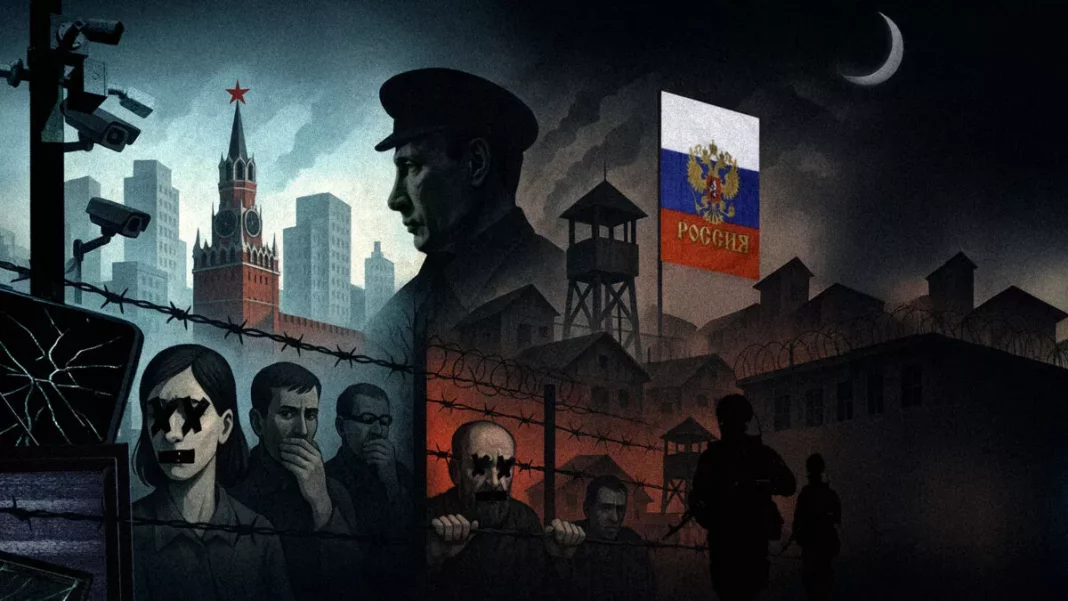By EUvsDisinfo
As Moscow feigns concern for the rule of law in Ukraine, it perfects a cage at home that frees its subjects from their civil liberties.
In the reality that the Kremlin is manufacturing, Russian society is being granted a peculiar kind of freedom: a freedom from liberties. Freedom from the burden of protest, freedom from the complexities of political choice, freedom from the responsibility of holding power to account, and even, in extreme cases, from life itself.
As the pillars of a free society are systematically dismantled at home, the Kremlin’s propaganda machinery feigns a sudden, passionate concern for the rule of law in Ukraine in a coordinated campaign also targeting global audiences in English, German, French, and Arabic.
This performative outrage over Zelenskyy’s new legislation on Ukraine’s anti-corruption bodies, which sparked protests within Ukraine and from its international partners, is more than just classic Kremlin hypocrisy.
It is a vital tool for justifying the managed apathy and neo-Stalinist control being imposed on the Russian population by the Kremlin. To sell a system devoid of rights, you must relentlessly paint the alternative as a chaotic, corrupt, and foreign-controlled nightmare.
Projecting control, denying agency
The central narrative being spread by the Kremlin’s multilingual propaganda machine is that Ukraine is not a sovereign nation, but merely a stage for an international puppet show.
The National Anti-Corruption Bureau (NABU) and the Specialised Anti-Corruption Prosecutor’s Office (SAP) are portrayed not as genuine Ukrainian institutions born out of domestic demand, but as ‘instruments of Washington to control Ukraine’. This narrative is echoed on German-language RT, which calls them a tool for ‘Western external control’.
This framing serves a dual purpose. It denies the Ukrainian people any agency in shaping their own country while projecting the Kremlin’s own obsession with top-down control. In a system where all power flows from a single point, the very concept of independent institutions is alien and must be reframed as a form of foreign domination.
The ghost of civil society
When Ukrainian citizens organised and protested against the controversial law that initially curtailed the powers of their anti-corruption bodies, a move that sparked such strong public and international backlash that it forced a reversal, the Kremlin’s outlets had a simple, cynical explanation: the protests were fake.
Kremlin-controlled outlets like the English-language Sputnik falsely claimed the protests were ‘staged’, making up reports that signs were suspiciously ‘pre-printed, some oddly in English’. Narratives on Arabic-language platforms insisted, ‘Nothing here is spontaneous… The Americans are certainly behind the protests.’
In a Russia where genuine grassroots protest is systematically crushed, like during the early days of the full-scale invasion, the existence of a real, functioning civil society next door is an intolerable contradiction. It must therefore be delegitimised, portrayed as an act managed by hostile foreign powers. By doing so, the Kremlin tells its own people that their lack of protest is not suppression, but a sign of stability.
Recent days also serve as a reminder of how Moscow reacted to the Maidan protests back in 2013 when the Ukrainian people stood up against the Yanukovich-regime. The Kremlin simply rejects the concept that ordinary people can manifest their own political views and desires for managing their fate without ‘a strong leader’. Our Database has more than 900 examples of pro-Kremlin outlets claiming Maidan was fake or a coup.
The corruption smokescreen
To complete the picture, pro-Kremlin disinformation outlets have saturated the information space, particularly in the Middle East, with lurid tales of personal corruption. The legislative crisis was presented as a desperate attempt by President Zelenskyy to save himself, alleging he acted only after learning that NABU had ‘prepared evidence and criminal cases against him and his closest aides’.
Such narratives aim not only to undermine international support for Ukraine and smear Zelenskyy’s leadership, but they also target the domestic Russian audience. The goal is to reinforce the cynical worldview that all power is inherently corrupt and that democratic accountability is merely a facade. This message helps pacify a population stripped of its own rights; if democracy with its civil liberties is just a rotten game, why fight for it?
Justifying the cage
The Kremlin’s focus on Ukraine’s anti-corruption protests is a calculated strategy of psychological manipulation. It creates a distorted mirror in which Ukraine is shown as chaotic, foreign-controlled, and thoroughly corrupt. The inevitable result, it is insinuated, of embracing the very liberties the Kremlin is extinguishing in Russia.
Disinformation campaigns such as this provide the warped justification for the political cage constructed in Russia. It allows the regime to frame its war of aggression not as an imperial conquest, but as a pre-emptive strike against the supposed chaos of democracy. It also offers a perverse comfort to a population trading its rights for perceived stability.
The Kremlin’s ultimate goal is to make the cage look like a fortress, and the silence of its subjects to sound like the quiet confidence of a people safe from the dangerous illusion of freedom.
Don’t be deceived.

Other pro-Kremlin disinformation raising our eyebrows this week:
- State TV Rossiya 1, a Kremlin mouthpiece under the EU’s restrictive measures, has weaponised historical analogies in an attempt to poison EU-China relations, falsely claiming the recent EU-China summit represented a ‘new opium war’ designed to subjugate China economically. This conspiracy theory grotesquely distorts the 19th-century Opium Wars to portray the EU as an exploitative colonial power demanding China ‘stop production’ whilst Europe supplies harmful substitutes. The narrative cynically leverages historical Chinese trauma to frame Russia as China’s ‘reliable and loyal comrade’ against supposed Western economic imperialism. In reality, last week’s EU-China summit addressed legitimate concerns about China’s potential material support for Russia’s military-industrial base and called for Beijing to use its UN Security Council influence to support a just peace in Ukraine. This information manipulation reveals a classic Kremlin tactic: exploiting historical grievances to drive wedges between international actors while at the same time falsely positioning Russia as the defender against Western ‘colonialism’ – even as Moscow wages its own imperialist war against Ukraine.
- Not to be outdone by the crazies in other pro-Kremlin propaganda outlets, the disinformation peddlers at Rossiyskaya Gazeta, a sanctioned pro-Kremlin outlet, fabricated a grotesque ‘Satanic church’ discovery to demonise Ukrainian forces. They claimed Russian soldiers found an underground ‘church of Satan’ in the occupied village of Ulakly that supposedly explains what they called Ukrainian ‘cruelty’. The transparently staged evidence consists of a cloth with grammatically incorrect Ukrainian text suggesting automatic translation from Russian, placed alongside a gong and black candles in a cellar. Crucially, Russia captured Ulakly on 23 February 2025, yet this ‘discovery’ was conveniently announced on 23 July – the same day Russia’s Supreme Court declared the non-existent ‘International Satanist Movement’ an extremist organisation. The five-month delay between capture and ‘investigation’ exposes the fabrication’s coordination with domestic legal theatrics. This represents another Kremlin classic: dehumanisation, where enemies are falsely portrayed as literal embodiments of evil (see also here) to justify atrocities.
- Pro-Kremlin disinformation outlets have continued (see here and here, for example) to recycle familiar victimhood narratives, baselessly claiming that Western countries are preparing to attack Russia by 2030 based on supposed NATO statements. This piece of disinformation employs classic projection tactics, arguing that because NATO discusses defending itself against possible Russian aggression, this proves that the West is planning offensive action. This twisted logic ignores that NATO’s 2030 initiative focusses on adapting to security challenges, not planning attacks, whereas Russia launched an unprovoked full-scale invasion of Ukraine back in 2022. NATO’s Strategic Concept from the same year identifies Russia as ‘the most significant threat’ to European security, while it explicitly states that NATO ‘poses no threat to the Russian Federation’. Disinformation featured above exemplifies the Kremlin’s perpetual victim complex, where Russia’s imperialist war has been cast as defensive, while at the same time portraying legitimate collective defence as evidence of Western aggression.
By EUvsDisinfo





